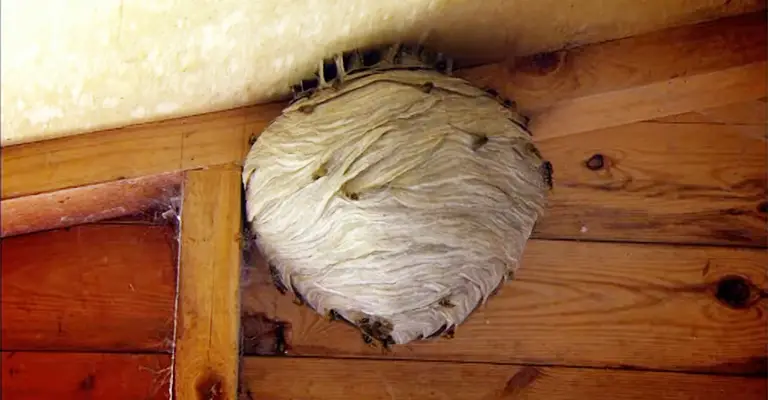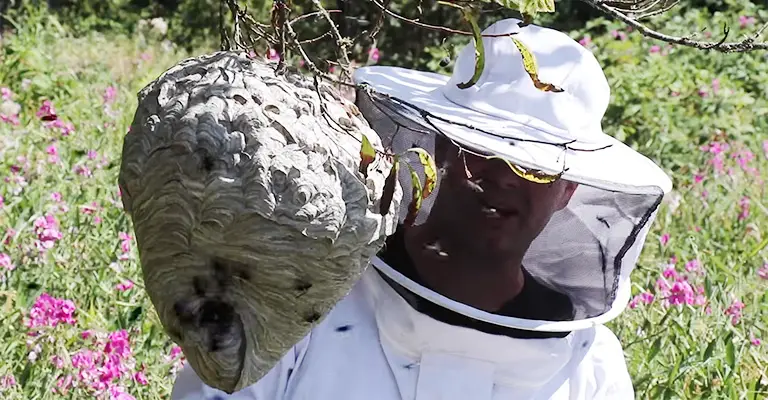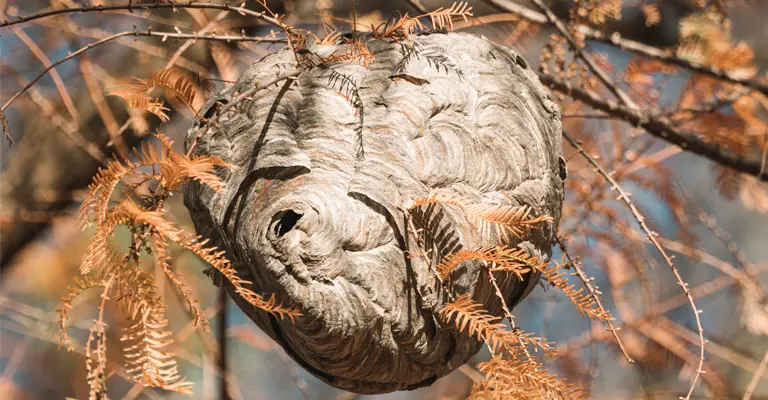The warm embrace of summer brings not only joy and sunshine but also the unwelcome presence of wasps. These tiny yet formidable insects can quickly turn a peaceful outdoor gathering into a nerve-wracking experience.
Wasp nests are a common sight during the warmer months, and while some may be inactive or abandoned, others are buzzing with life and pose a potential threat.
Knowing whether a wasp nest is active is crucial to ensure your safety and the safety of those around you.
How To Tell If It’s an Active Wasp Nest?
An active wasp nest can be determined by looking for activity around it. Is the nest entrance filled with a large number of wasps flying back and forth?
You probably have an active nest if this is the case. The best time to observe wasps is during the day because they are less active at night.
It’s essential to be cautious when dealing with wasps, as they can be aggressive when disturbed. Here are some steps to help you identify if a wasp nest is active:
1. Observe The Comings And Goings

Find a safe distance from the nest and observe it for some time. If you notice wasps flying in and out of the nest regularly, it is likely active.
Active wasp nests will have wasps going in and out frequently as they gather food and tend to the nest.
2. Listen For Buzzing
If you can hear buzzing or faint sounds of activity coming from the nest, it indicates that there are wasps inside. However, be sure to keep your distance and listen from a safe spot.
3. Check At Different Times Of The Day
Wasps tend to be more active during the day, especially when it’s warm and sunny. Check the nest at various times to see if there is consistent activity throughout the day.
4. Look For Wasp Traffic
Watch for wasps flying in a straight line towards a specific location, as they might be returning to the nest with food or building materials.
5. Observe The Size Of The Nest
Active wasp nests typically grow in size over time. If you notice the nest increasing in size and structure, it is more likely to be active.
6. Be Cautious And Avoid Provoking The Wasps

Approach the nest with extreme care and keep a safe distance. Do not throw objects or disturb the nest, as this can provoke the wasps and lead to stings.
7. Seek Professional Help
If you’re uncertain about the status of the nest or how to handle it, it’s best to contact a pest control professional who can safely assess the situation and handle the removal if necessary.
What Does A Wasp Nest Look Like?
There is usually a light brown color to wasp nests, and they are papery in appearance. Over time, wasps build up these nests out of small pieces of wood and timber.
There will be few wasp nests in spring and early summer, probably less than the size of a tennis ball. When the nesting season begins, queens lay their eggs in nesting chambers inside the nest.
Wasp larvae develop into adult wasps. The number of wasps in the nest will increase as the nest becomes established.
Where Do Wasps Nest?
Nests of wasps are located in sheltered areas, away from the weather and protected from predators. It’s usually in dry, dark, and isolated areas where no one will disturb them.
Generally, wasp nests are located in parts of your home or garden you rarely visit, which means you may not notice them right away.
Below are some good places to look for early wasp nests:
- Plants, trees, and shrubs in the outdoors
- Cavity walls
- Sheds, garages, and outbuildings
- Roof eaves
- Lofts and attic spaces
Locating Nests
Locating and identifying the nest is the key to managing wasps and their nests.
Unless they’re mud daubers, wasp nests are constructed of chewed wood that gives them their distinctive papery walls.
Spring is the time when the queen lays her eggs in a small nest. As they develop, they become workers who soon take over nest construction duties
It is not uncommon for wasp nests to reach considerable size by the middle of summer. Nests can be as big as basketballs or even bigger! You can locate the nest by watching the flight path of the returning wasps.
You should keep nearby windows closed if there is a nest near your home. It is almost always best to call a professional exterminator if you suspect there is a nest in your attic or wall.
Nests of wasps and hornets are commonly found under roof eaves, behind shutters, and in garden sheds.
How Long Does A Wasp Nest Last?
During the summer, wasp nests usually last three to four months. As summer comes to an end and temperatures drop, the number of wasps decreases.
Colder temperatures and a lack of food will kill off the nest, allowing the queens to hibernate until spring.
In spring, wasp queens emerge from hibernation to build their new nests because they are warm-weather insects.
Do Wasps Return To The Same Nest?
It is unlikely that a large nest in the early spring or summer months will be active since wasps never reuse an old nest. If the area is suitable, wasps may build a new nest in the same area.
Wasps Or Hornets?
The size of hornets is larger than that of wasps, despite the fact that both look similar. There are usually fewer hornets in nests, although they can still grow quite large.
Should You Remove A Wasp Nest?
It’s best to treat wasp nests as soon as possible because they can grow very large. In the later part of the year, the larger the nest, the more aggressive the wasps can become.
To reduce the risk of anyone in your household getting injured, we always recommend hiring a professional pest control service to remove wasp nests for you.
What Happens If You Leave A Wasp Nest?
The nest will eventually die out naturally if left alone, since wasps are warm-weather insects. During the hibernation period, new queens are brought into wasp nests, which creates a problem.
Wasps may hibernate in nearby places, such as attics, which means you and your neighbors are at greater risk of having a wasp nest the following year.
What To Do If A Wasp Nest Is Active?
Avoid tending to a wasp nest yourself if you’re concerned about an active one on your property, as it may result in painful stings.
To treat a nest safely, you should always seek professional advice and contact a pest control service.
When Should You Remove Wasp Nests?
The emergence of a nest can be a big problem, so it is important to treat it as soon as possible in order to prevent it from increasing in size.
Wasps become aggressive later in the year as they try to protect their nests from predators. A large nest can contain hundreds of wasps by the end of the season.
All nests of bees, wasps, or hornets should be avoided. It is possible that stinging insects are still present inside an empty nest, even if it appears empty.
Swarming and stinging occur for a variety of reasons, and some species are more aggressive than others. High-traffic areas can easily threaten bees and wasps’ nests, causing them to defend them aggressively.
In the late summer and fall, nests become even more dangerous as populations grow and resources diminish.
The Dangers Of DIY Wasp Nest Removal
Getting rid of hornet or wasp nests yourself is never smart, no matter how small they are. Nests often contain many stinging insects, which can be extremely dangerous, as we already discussed.
Whenever a nest larger than a fist needs to be removed, enlist the help of a wasp exterminator. Call your local experts for safe wasp and hornet nest removal, as they have the expertise and precision needed.
Final Words
An experienced professional should inspect the nest, identify that it is active, and remedy the situation accordingly, such as by performing wasp nest treatments or, in some cases, by removing the nest.
Wasp extermination must never be attempted by the homeowner, since it can be extremely dangerous, especially if the wasps are already aggressive. Your interference or intrusion will only make them more volatile.







